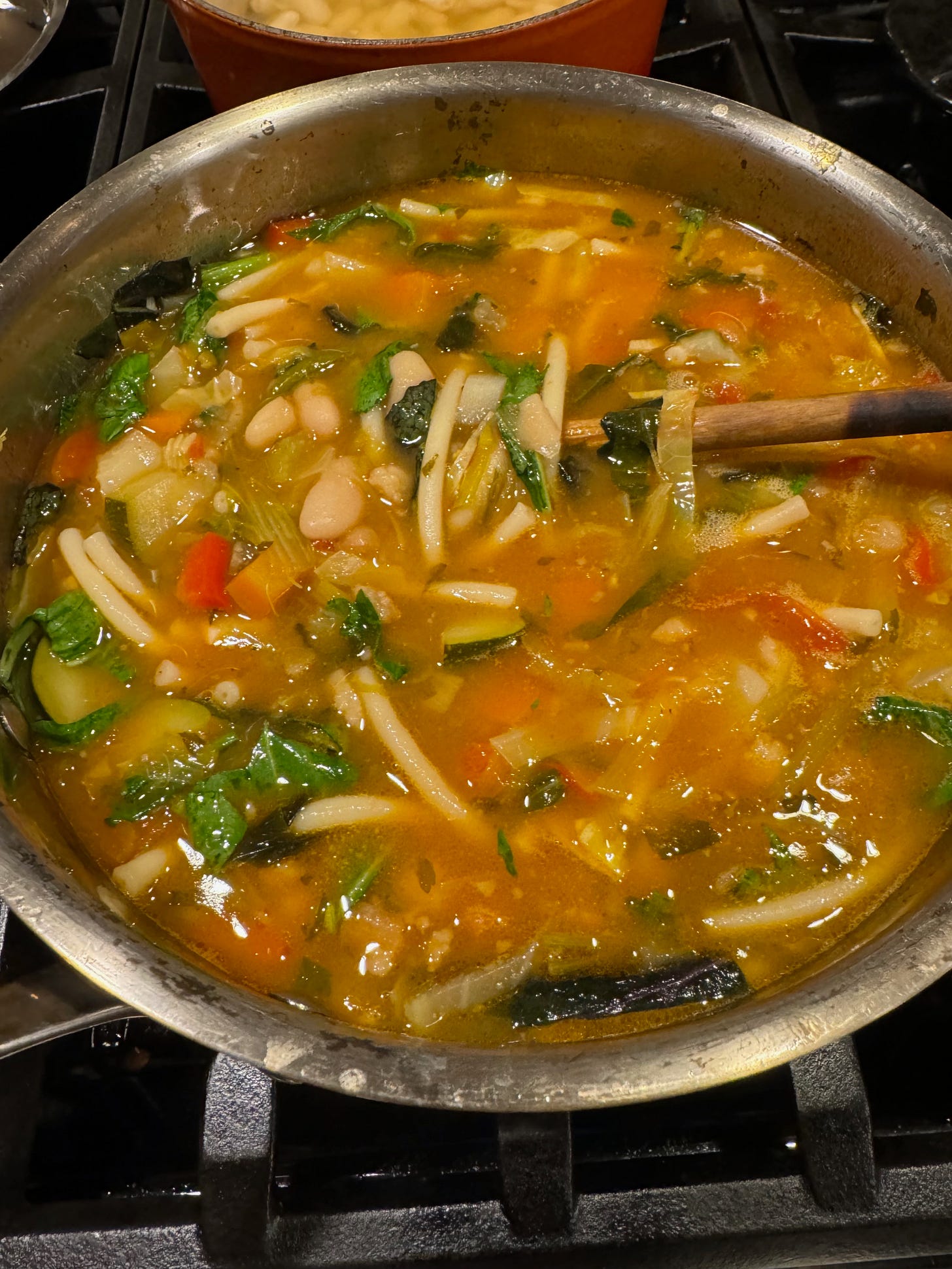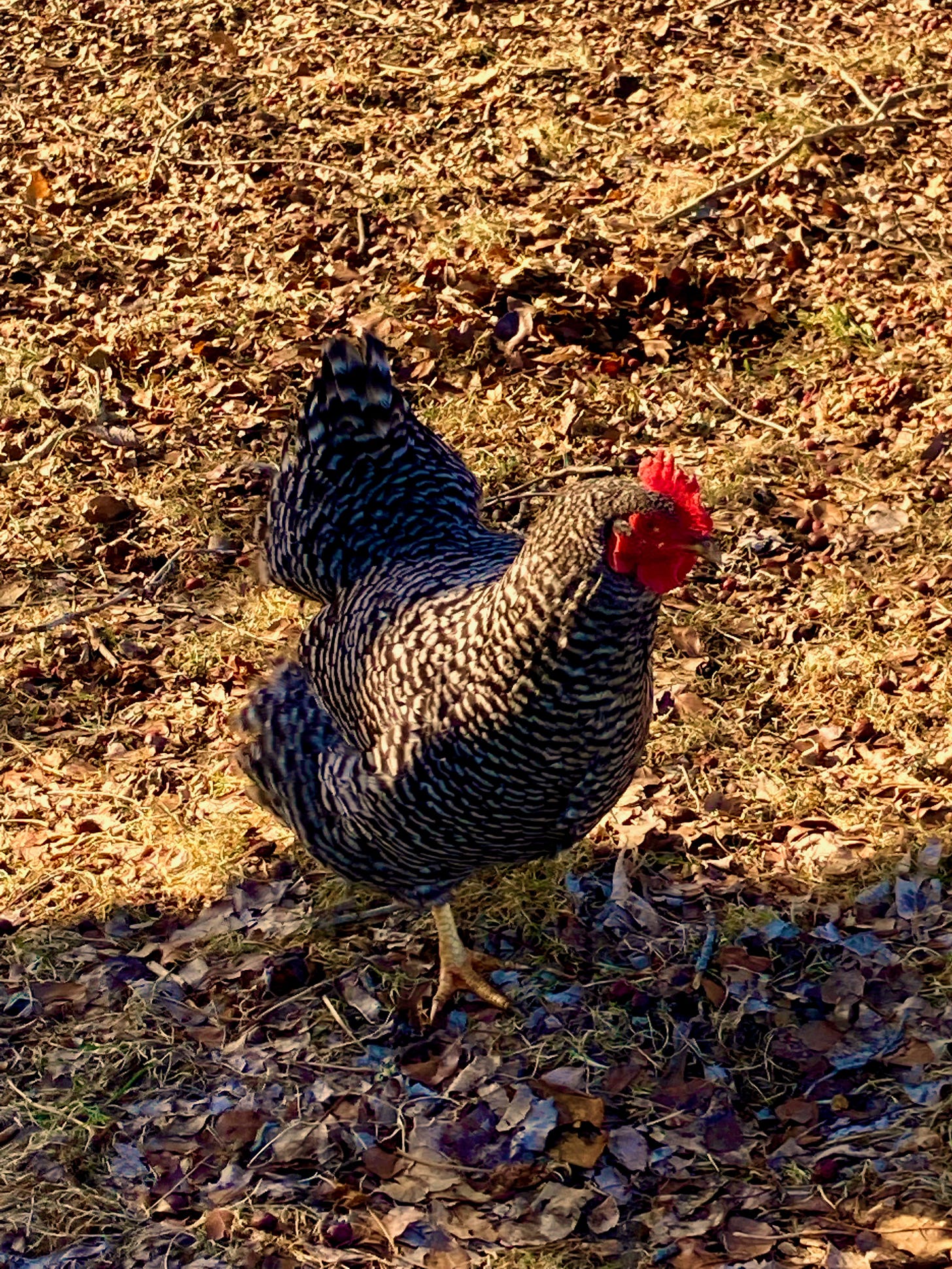Taking Stock/Making Stock/Using Stock
with a memory, a profile, and a recipe for great minestrone
On Finding Six Chicken Feet Deep Within the Freezer
If I were a poet, I could compose a sonnet to chicken feet.
But I am not a poet, fortunately for you, dear readers.
Still, there is something oddly poetical about chicken feet, their weirdly twisted shape, their pale, unearthly color, the potential locked within those bones. These particular feet had been purchased almost a year ago from a chicken farmer who sells her wares in the Brunswick, Maine, winter market at Fort Andross, an old mill complex on the banks of the Androscoggin River. The chicken feet were as clean as clean could be. It was my cooking pal Zora who insisted I buy them, so I did, took them home and then . . . well, unable to use them immediately I wrapped them securely in a double layer of foil, folding the wrapper tightly so the feet, with their tiny, curved claw-nails, were protected from any air pockets. I tucked them away in the freezer where, like many such items, they gradually migrated to the back.
And there they still were when it came January and the semiannual freezer clean-out. There was nothing to do but make chicken stock and that I did. Few things in the archives of stock-making add a richer, more velvety, unctuous, gelatinous texture to a stock than chicken feet. Even knuckle bones don’t have quite the same effect.
Of course, chicken feet were not the only thing that went into the stock. There was also a chicken, of course, around 4 ½ pounds, cut into parts, as well as vegetables—a leek, a couple of carrots, 2 sticks of green celery, an onion (the peel left on to give rich color to the broth), a couple of garlic cloves, a couple of bay leaves, a handful of green parsley and another of thyme from the bush still standing underneath the snow in the winter herb garden. I trimmed and sliced the leek, carrots, and celery, then set up the stock pot. In the bottom of the pot, I browned off all the vegetables in olive oil, added the chicken parts and toasted them on both sides until they were spotted with gold. I threw in some sea salt, plenty of black pepper, and a small dried red chili pepper, then used a glass of dry white wine to deglaze the pan and scrape up all the good flavors. At that point I added the chicken feet and then water, around 8 cups to start with, enough to cover all the ingredients to a depth of an inch or so, and brought it slowly to a simmer, over medium low heat. Once it was simmering, I added two cups of tap-cold water and let it come to a simmer again.
At that point, I turned down the heat and watched the frothy bits that rise to the top. For very clear stock, you have to skim that froth as it rises. I have a handy small sieve that works well for the task, rinsing it between skims. Skim and rinse, skim and rinse, and when the froth had ceased rising, I covered the pot and simmered very, very gently for an hour and a half, or until the bird was so thoroughly cooked it was falling apart. (It could have cooked longer too, extracting more and more flavor.)
Throughout that time, I added now and then, as the liquid in the stock pot cooked down, another cup of tap-cold water and brought it back to a slow simmer. I probably used a good 12 or 13 cups in all, from start to finish.
At the end of the cooking time, I strained the stock through a double layer of cheesecloth draped over a fine-mesh sieve. I tossed the vegetables, the aromatics, and the chicken feet into the compost bin, and also discarded the skin and bones from the chicken. After all that cooking, the chicken meat had given up most of its goodness to the broth, but it still made a fine chicken salad sandwich, while the skin went right into the dog’s bowl. Then the strained stock was moved to the fridge and sat there overnight while the fat rose and congealed on top, after which I skimmed it off with a slotted spoon.
As the stock chilled down, it set up, thickening and gelling into a flavorful aspic. I brought it to a simmer once again, tasted it, added a little more salt and plenty of ground black pepper, and then transferred it to refrigerator containers—one cup, two cups, and a full quart, to have available for any eventuality.
This is a great basic stock to have on hand for the many times when a well-flavored stock is called for—risotto, soup, sauces, or just a warm and fragrant broth to cure a winter cold. The technique is something I learned from my daughter-the-chef, adding cold water periodically; it tends to keep the stock cooking at a constant, steady, low simmer. It should never come to a rolling boil, Sara says, as that simply redistributes impurities.
And what to do if you don’t have a good source of chicken feet and none buried in the back of your freezer? Leave them out, dear cook, just leave them out. You won’t achieve the miraculous jelly that the feet give the stock, but you’ll still have a remarkably flavorful broth for all those many uses.
And of course, if push really comes to shove and there’s no time to make it from scratch, you will use a commercial stock. I keep a jar of Better Than Bouillon’s roasted chicken base in my refrigerator for just that purpose.
Minestrone (as made by Pellegrino, Pellegrini, my Tuscan neighbors, my daughter-the-chef, and myself)
Now, here’s one fine use for chicken stock. Traditional in Italy, minestrone as I make it has evolved from various sources, including my own kitchen practice, honed over a half century or so of making a proper Tuscan minestrone and watching many other people, friends and neighbors, cooks and chefs, do the same.
But first, what the heck is minestrone anyway? For that, I refer you to any elementary Italian language text where you will find reference to an interesting characteristic of la bella lingua called the augmentative form. This is when you take a simple noun or adjective and augment it, make it bigger, by adding -one (pron. oh-nay) or -ona or -oni to the ending. So minestra, which means simply soup, becomes minestrone, a big soup, filled with many different kinds of seasonal vegetables, usually including beans (cannellini, borlotti, zolfini) or chickpeas, and also a little pasta to round things out.
I adore the augmentative form. I wish we had it in English.
A very big soup, thus, and one that’s served all over Italy but closely tied to cold-weather farmhouse cooking, as we shall see. Although minestrone can be a first course (a primo) in restaurants, at home it’s most often served as a piatto unico, a one-dish meal, consumed in the evening at the long family table set up close to the fire while the tramontana, the north wind, howls outside. At least, that’s the way I’ve experienced it in the hills of eastern Tuscany.
But even though it’s the epitome of cucina contadina, peasant cooking, minestrone is honored in the same way as so many old-fashioned, earth-bound dishes in Italian kitchens. Honored because it celebrates the connection between the garden and the table, between the field and the kitchen. When it’s served, it comes with the unspoken conception that quality in food, as well as in wine, begins with attention to the ways in which food, whether a plant or an animal, is grown and nurtured, and the respect and consideration with which it’s prepared.
Over a lifetime I’ve happily explored the length and breadth of Italy, learning about the Italian experience from farmers, chefs, cooks, and food producers, in market stalls, restaurants, fancy food shops, and home kitchens alike. But it was in a backyard garden in the near-suburbs of Seattle, Washington, that I really came to understand the depth of that garden-to-table connection. And it was minestrone that helped me to appreciate it.
Angelo Pellegrini, at the time I met him, was 86 years old, slight, gently stooped, walking with the support of a stout cane. This was more than 30 years ago when he was already an emeritus professor of English at the University of Washington, and a much loved teacher, not so much of English literature (although that too) as of that almost innate Italian sense of the link between what goes on the table and what grows in the soil. You could say (and I did) that his subject was really the Italian way of life, which he taught by example to his students, his friends, his colleagues, and everyone who came in contact with his writing, especially The Unprejudiced Palate, first published in 1948 and still very much in print.
In that book, he distilled a lifetime’s experience: ''I am convinced that no one, much less one in moderate circumstances, can satisfy a cultivated palate every day of the year without a garden and a cellar of his own,'' he wrote. ''A vegetable taken from the soil an hour or two before it is eaten is vastly superior to the commercial product that has frequently lain in storage for days or weeks before it gets to the dinner table.''
Despite his age, Pelle, as he was known by all, was clearly happy puttering in his garden, filled on that summer morning with vegetables and herbs, carrots, beets and turnips in tidy rows, clumps of green lettuce and trailing cucumber vines; poles of climbing beans and low bush beans; sturdy onions, shallots, garlic, and leeks; lush thickets of raspberries, and along the garden's eastern edge, artichokes and cardoons, their big, feathery, silver-gray leaves forming a graceful border to the abundance.
I say he was happy in his garden, but he might have been even happier in the kitchen, the door of which opened right into the garden so that no time was lost between the pulling of those onions, leeks, garlic, and fresh parsley and their transformation into the soffritto of chopped vegetables that, bathed in olive oil and nourished with an ounce or two of diced pancetta, begins just about every sauce and every soup in la cucina italiana. He was the king of his kitchen (his wife Virginia helped out, but only when invited) and that day when I visited, he was making what he called his two-step minestrone.
Keep reading with a 7-day free trial
Subscribe to On the Kitchen Porch to keep reading this post and get 7 days of free access to the full post archives.



